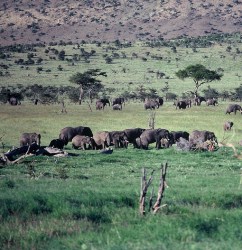Serenity on the Serengeti?
It may be inconceivable that world-famous places like the Serengeti plain of Africa could be anything but secure. But like many other World Heritage sites, the very features which draw thousands of visitors each year are under pressure.
The vast plains of the Serengeti cover 1.5 million hectares of savannah. The annual migration to permanent water holes of vast herds of wildebeest, gazelles and zebras, followed by their predators, is one of the world’s most impressive natural events.
This area, which has inspired writers and film-makers alike, is home to around 70 large mammal species and some 500 bird species in highly diverse habitats including forests, swamps and grasslands. The Maasai people have grazed their livestock on these plains for around 500 years.
Yet road building, invasive alien species, wildfires, poaching and human-wildlife conflicts are putting serious pressure on Tanzania’s Serengeti National Park which was inscribed as a World Heritage site in 1981.
|
“These threats emanate mainly from outside the borders of the protected area and have an impact on the entire Serengeti-Mara ecosystem,” says Leo Niskanen, Technical Coordinator at IUCN’s Office for Eastern and Southern Africa (ESARO). “This highlights the importance of close collaboration between protected area managers in Tanzania and Kenya and the need to involve a broad group of stakeholders—including the private sector, conservation organizations and government agencies—on both sides of the border.” |
A good example of such collaboration is the work being carried out under the auspices of the Lake Victoria Basin Commission, an institution of the East African Community, to develop sustainable management of the Mara River basin. This is critical for ensuring that the water needs of both the wildlife and human populations continue to be met.
IUCN ESARO’s Conservation Areas and Species Diversity Programme has recently advised the Serengeti management on the new fire management plan for the park and is currently planning activities to help manage biological invasions in the Serengeti in close collaboration with the management authority of the Ngorongoro Conservation Area (also a World Heritage site) and the neighbouring Masai Mara National Reserve.
|
“Such approaches should be extended to address some of the other threats facing the ecosystem,” says Niskanen, “and we need to act fast if we are to save the unique natural qualities of this incredible place.” |
For more information contact:
Leo Niskanen, leo.niskanen@iucn.org






